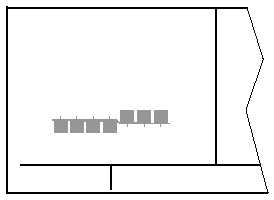TM 1-1510-225-10
3D-53
(5) To perform a RAIM prediction, perform
the following steps.
1. Use the left outer and inner knobs to
select the STA 5 page.
2. Press the left CRSR button. The
cursor will be over the DEST field.
3. If
necessary,
enter
the
desired
waypoint identifier by using the left
inner and outer knobs.
4. Once the desired waypoint identifier
is entered, press the ENT button.
Press the ENT button again if the
information is correct.
5. The cursor will now be over the ETA
field. If necessary, use the left inner
and outer knobs to enter the desired
time and time zone. When the
desired time is entered, press the ENT
button. The RAIM calculations will
start. The calculation will usually take
a few seconds.
6. Once
the
RAIM
calculation
is
complete, the STA 5 page will indicate
the results of the test. Refer to Figure
3D-72. This is done graphically in a
bar graph. The center of the bar
graph represents the ETA. Each bar
represents 5 minutes of time. The
RAIM
calculation
is
good
for
± 15 minutes of the ETA. Bars that
are above the line indicate RAIM is
available and bars below the line
indicate when RAIM is not available.
STA 5
RAIM STATUS
DEST: 3K1
ETA: 14:35
UTC
-15 0 +15
Figure 3D-72. RAIM Status
(6) Even more rare will be the case when the
KLN 90B cannot provide sufficient integrity monitoring
or if there is an actual satellite failure while the aircraft
is on the leg from the FAF to the MAP. In these cases,
the KLN 90B will flag the navigation solution and a
missed approach will have to be flown. The KLN 90B
will provide the following message, PRESS GPS APR
FOR NAV.
1. Press the external GPS APR button.
This will change the unit to the
approach arm mode and navigation
information will be restored.
3D-22. SID/STAR PROCEDURES.
The database contains the pilot's NAV SID's and
STAR's for the primary database coverage area.
SID/STAR procedures stored in the database can only
be considered accurate as long as the database is
current.
Even
though
the
database
contains
SID/STAR procedures, there is a lot of information that
is not included in the database. Therefore, the paper
chart is still the primary source of information. Many
procedures require the aircraft to fly at a certain
altitude, along a heading until intercepting a course
and many other procedures that the KLN 90B cannot
automatically accomplish. Many procedures require
pilot action to ensure that the proper path is flown over
the ground. The main purpose of loading a SID or a
STAR into the active flight plan is to provide a quick
way of loading a potentially large number of waypoints.
NOTE
There are some SID / STAR procedures
that are not suited for the operational
characteristics of the KLN 90B. These
procedures
are
not
included
in
the
database.
SID and STAR procedures are stored with the
airport for which they apply. SID and STAR
procedures are accessed through the APT 7 page. If
there are both SID's and STAR's for a given airport,
there will be two APT 7 pages, one to select a SID and
the other to select a STAR. This is indicated by
APT+7.
SID and STAR procedures are defined in three
parts: the name, the transition, and the runway
component. The APT 7 page leads the pilot through
the selection process.
a. Selecting a SID.
1. Select the departure airport APT 7 or ACT
7 page.

